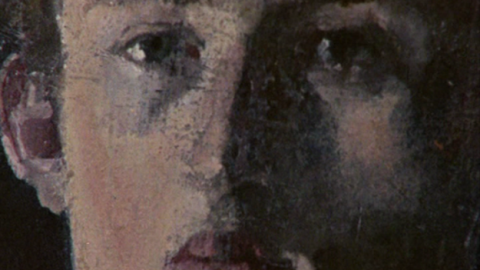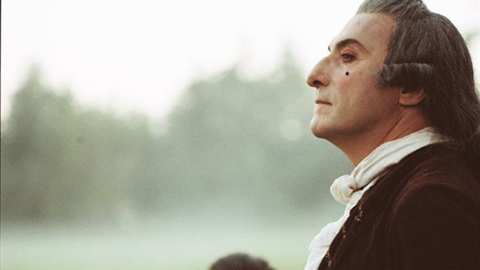Cannes Interview: Albert Serra
Known for his provocative reimaginings of Don Quixote, Casanova, and the Three Kings, Catalonian director Albert Serra has, over the course of 10 years and four features, established himself as an artist of singular talent and irascible temperament. With The Death of Louis XIV, Serra again looks to the past for inspiration, but the results are, surprisingly, more reverent than rebellious. Starring Jean-Pierre Léaud as France’s longest-reigning King during his final days as he slowly succumbs to the effects of cardiac arrhythmia and gangrene, the film observes in a patient, crestfallen manner how one of history’s most famous rulers and a selection of his closest confidants approach an inevitable fate with dignity and reserve. Restricting the drama to the confines of the King’s bedchamber and sparing in his use of extraneous formal gestures, Serra has crafted a ravishing, darkly witty evocation of 18th-century aristocracy and a neoclassical period piece as reminiscent of the historical films of Visconti and Rossellini as the modernist literary adaptations of Rohmer and Oliveira.
Serra sat down with FILM COMMENT at Cannes shortly after The Death of Louis XIV premiered as an Out of Competition selection to talk about his unique on-set process, his film’s more restrained tone, and working with one of French cinema’s most beloved actors.
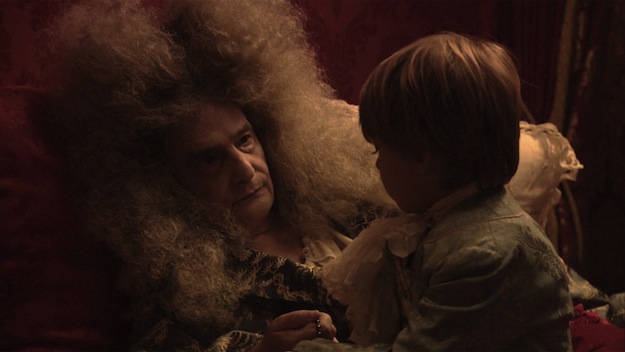
You once described your previous film, Story of My Death [13], as “unfuckable.” Your new film, The Death of Louis XIV, isn’t all that difficult by comparison. In fact, it’s almost classical. It’s fuckable!
[Laughs] Yes, it’s fuckable! It’s a very classical film. I originally used that term because I tend to shoot my films in the present, in near real-time, at least psychologically—as a kind of performance. It can sometimes be very difficult for people to figure out the ideas behind the films, or to see my intention. Story of My Death is a total magma of despair and crazy ideas. It’s very difficult to say what the film actually is, or even if the film was different that it would somehow be better or worse.
The actors contribute to this effect as well, through the mystery and despair inside them. They don’t really get to work with ideas. Because of my process, which is based around non-communication, it can be difficult for them to even have an idea of what I want. Because I might not even know what I want! I shoot the film to know, or at least to live and watch these images. The magic of cinema is not to create images but to watch images. It’s an instant. It’s a moment. It’s not an idea of an image—it’s an image. They’re not interchangeable. Each one is unique. So if my films are unfuckable, it’s because they’re unique.
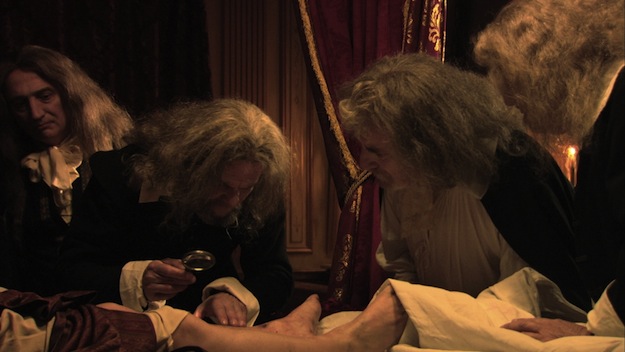
This film is much more reverent that some of your past works, in which you play fast and loose with the material. There’s a solemn tone to the film that’s appropriate to the subject.
If it seems more reverent, it’s because of the subject. In this story there’s a unity of time, a unity of space, a unity of action, a unity of character. It’s difficult to be iconoclastic here, without just being provocative with empty ideas. So there’s a more inherent homogeneity to the film. And in the end it might be more conventional, which I am a little bit ashamed of [laughs]. I’m sure everyone was expecting more crazy things. But this was the best possible edit for the film. If crazy ideas would have worked better for the film, then I would have done it. I didn’t know, because of my process, how it was going to turn out—that it would actually be so smooth.
But I think it’s still probably crazy enough for most people [laughs]. The rhythms are still quite slow, and there are a lot of repetitions in the action. We are in one room, and we are very close to the action, and we have an external point of view—but even still, we are not in contemplation. Even though some people have been telling me that the film is moving, there is no identifying with the character—at least not for me. Maybe it’s just on the edge of being moving, or of being sentimental.
There seems to be a lot of very specific detail in the King’s demeanor and in the actions of those around him. Did you base the film on any specific texts?
Yes, on the memoirs of Saint-Simon, a very important French writer of the time. These were what I like best, but we also did further research and looked at some other historical texts. The film is very faithful to history. But there is also some poetic license, because otherwise the film wouldn’t feel present. One idea behind the film is the idea of living the present through the past. Not living the past through memory. I’m respectful with the past and with the story. But then again, I am an artist.
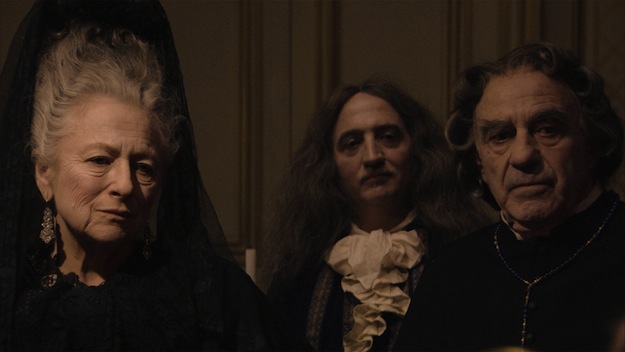
The King is incapacitated for much of the film, but you make room for a few revealing and intimate moments. At one point he talks to his great-grandson and lends him both moral and bureaucratic advice.
Another idea behind the film was the idea of how someone with absolute power deals with impotence. You can have all the power, but because of illness and aging, how do you deal with the finishing of your body—and, for those who know history, with the end of the State? Even if you’re the Sun King, you have no power over the end of this. It’s a beautiful lesson, and it’s one that he tries to relay to his heir.
Your images are not only painterly, they seem as if they could be directly replicating 18th-century painting. Is this something you look at while making the film?
No, not really. I mean, I know and respect these works—and there’s a plastic aspect to my films—but my way of working doesn’t allow for that kind of consideration. We were shooting with three cameras and in continuity, so I couldn’t really be stopping to so carefully compose every shot. On set I’m more concentrated on actors. For me its boring to be thinking about light or the plastic aspects of the image while shooting. I prepare most of those details—such as the colors and costumes—beforehand. But during the shooting I prefer to be working with atmosphere and actors. My system is an attempt to destroy a lot of previously held ideas and historical precedences. I like to focus on that destruction while I’m on set.
Did you shoot the film on a stage?
In a castle, actually. But in a barren castle. All the floors and ceilings and walls were cement. Everything you see was created from zero. In the beginning we were supposed to use some of the other rooms in the castle, plus some of the furniture. But that didn’t happen. So it was on location, but in an empty one [laughs]. It’s all part of how I shoot, though. I like a little bit of chaos. It creates an atmosphere on set that I love. Plus, it’s more funny. I decided to start making cinema because it’s funnier than routine life. Sometimes you have to create these funny moments. And to get these funny moments, chaos helps.
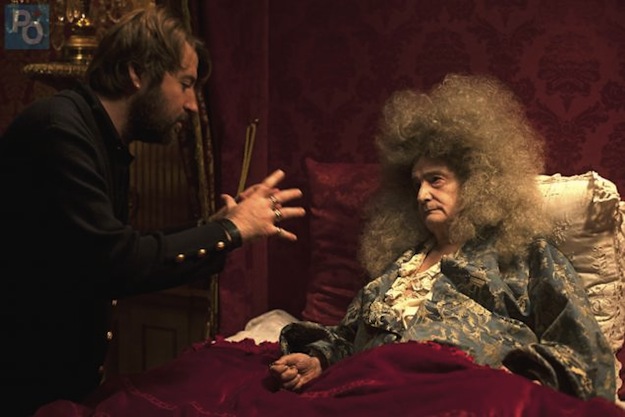
Did you always envision Jean-Pierre Léaud in this part?
The collaboration actually started three to four years ago as a project commissioned from the Centre Pompidou. It was to feature Jean-Pierre performing Louis XIV’s death over the course of 15 days while lying in bed inside a glass cage. The project was ultimately canceled because of budget problems, but a few years later we decided to revisit this same idea, but for the cinema. But we tried to stay faithful to this original idea, of his death as a performance and with a unity of space and time and everything I previously mentioned. And maybe that’s the point: that, despite this unity, it can be a lively scene for the spectator.
Jean-Pierre had his own ideas about a few things, of course. But my approach is strong enough that it ultimately subsumes the actors’ process. It’s like lava from a volcano, covering everything and turning everything black, everything uniform—creating an erosion and reforming everything as one color. But what’s important is the atmosphere that results from the methodology, and what creates the intensity that you see on the screen afterwards. So in that way, Jean-Pierre was perfect. I admire him as person, but I wasn’t interested in his past as an actor. For me it started with his integrity as a person and his character. And from there anything is possible.
Jordan Cronk is a Los Angeles–based critic and programmer and contributor to Cinema Scope, Sight & Sound, Cineaste, Reverse Shot, and The Los Angeles Review of Books.



